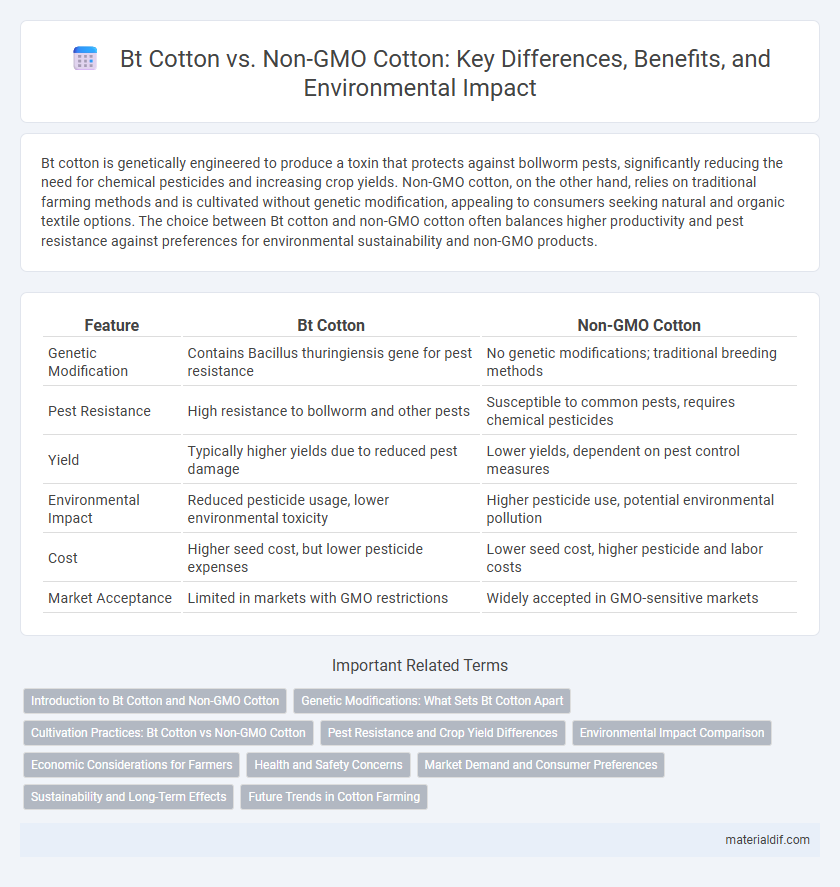Bt cotton is genetically engineered to produce a toxin that protects against bollworm pests, significantly reducing the need for chemical pesticides and increasing crop yields. Non-GMO cotton, on the other hand, relies on traditional farming methods and is cultivated without genetic modification, appealing to consumers seeking natural and organic textile options. The choice between Bt cotton and non-GMO cotton often balances higher productivity and pest resistance against preferences for environmental sustainability and non-GMO products.
Table of Comparison
| Feature | Bt Cotton | Non-GMO Cotton |
|---|---|---|
| Genetic Modification | Contains Bacillus thuringiensis gene for pest resistance | No genetic modifications; traditional breeding methods |
| Pest Resistance | High resistance to bollworm and other pests | Susceptible to common pests, requires chemical pesticides |
| Yield | Typically higher yields due to reduced pest damage | Lower yields, dependent on pest control measures |
| Environmental Impact | Reduced pesticide usage, lower environmental toxicity | Higher pesticide use, potential environmental pollution |
| Cost | Higher seed cost, but lower pesticide expenses | Lower seed cost, higher pesticide and labor costs |
| Market Acceptance | Limited in markets with GMO restrictions | Widely accepted in GMO-sensitive markets |
Introduction to Bt Cotton and Non-GMO Cotton
Bt cotton is a genetically modified variety engineered to express Bacillus thuringiensis toxins that target specific insect pests, reducing the need for chemical pesticides and enhancing crop yield. Non-GMO cotton, on the other hand, is cultivated from traditional or hybrid seeds without genetic modification, relying on conventional pest management and farming practices. The comparison between Bt cotton and non-GMO cotton centers on pest resistance, environmental impact, and production efficiency.
Genetic Modifications: What Sets Bt Cotton Apart
Bt cotton incorporates a genetically modified gene from Bacillus thuringiensis, producing an insecticidal protein that provides built-in pest resistance, significantly reducing the need for chemical pesticides. Non-GMO cotton lacks this genetic modification, relying on traditional pest management practices to protect crops, which can increase pesticide usage and production costs. The distinct genetic modification in Bt cotton enhances crop yield and sustainability by minimizing pest damage and chemical inputs.
Cultivation Practices: Bt Cotton vs Non-GMO Cotton
Bt cotton cultivation involves genetically engineered plants that produce Bacillus thuringiensis toxin, providing inherent pest resistance, reducing the need for chemical insecticides, and promoting sustainable farming practices. Non-GMO cotton cultivation relies heavily on traditional pest management techniques, including frequent pesticide applications and crop rotation to control pests and maintain soil health. The adoption of Bt cotton often results in lower input costs and higher yields, while non-GMO cotton offers advantages in organic farming systems and markets demanding GMO-free products.
Pest Resistance and Crop Yield Differences
Bt cotton contains genes from Bacillus thuringiensis that produce proteins toxic to specific pests, significantly reducing damage and lowering the need for chemical pesticides. Non-GMO cotton lacks these pest-resistant traits, often resulting in higher pesticide use and greater vulnerability to insect infestations. Studies show Bt cotton delivers higher crop yields and more consistent production due to improved pest resistance compared to non-GMO cotton varieties.
Environmental Impact Comparison
Bt cotton, genetically engineered to resist bollworm pests, significantly reduces the need for chemical insecticides, lowering soil and water contamination compared to non-GMO cotton. Non-GMO cotton typically requires higher pesticide applications, contributing to greater environmental toxicity and harm to beneficial insect populations. Studies indicate that Bt cotton cultivation leads to improved biodiversity and reduced greenhouse gas emissions through decreased chemical inputs.
Economic Considerations for Farmers
Bt cotton offers farmers increased yield potential and reduced pesticide costs, translating into higher profitability compared to non-GMO cotton varieties. The upfront seed cost for Bt cotton is typically higher, but this investment is often offset by savings on pest management and improved crop resilience. Non-GMO cotton may appeal to niche markets with premium pricing, but overall, Bt cotton's economic advantages make it a preferred choice for large-scale producers aiming for cost efficiency and higher returns.
Health and Safety Concerns
Bt Cotton incorporates a gene from Bacillus thuringiensis that produces a protein toxic to specific pests, reducing the need for chemical insecticides and potentially lowering exposure to harmful pesticides for farmers and consumers. Non-GMO cotton lacks this genetic modification but often requires more frequent pesticide applications, which can increase risks related to chemical exposure and environmental contamination. Studies indicate that Bt Cotton's reduced pesticide usage contributes to improved health outcomes among agricultural workers, though ongoing monitoring of long-term safety remains essential.
Market Demand and Consumer Preferences
Bt Cotton, engineered with Bacillus thuringiensis genes for pest resistance, has gained significant traction in global markets due to its higher yield and reduced pesticide use, addressing both farmer profitability and environmental concerns. Non-GMO cotton appeals strongly to segments prioritizing organic and sustainable fashion, driving demand in niche markets where chemical-free production enhances consumer trust. Market dynamics reveal a growing consumer preference for transparency and eco-conscious products, influencing the rise of non-GMO cotton in retail, while Bt Cotton remains dominant in large-scale agricultural production due to its cost-effectiveness and resilience.
Sustainability and Long-Term Effects
Bt Cotton enhances sustainability by reducing the need for chemical pesticides, lowering environmental impact, and increasing yield efficiency compared to Non-GMO Cotton. Long-term effects of Bt Cotton include potential development of pest resistance and concerns about biodiversity loss, whereas Non-GMO Cotton maintains traditional cultivation practices with variable pest management success. Sustainable cotton farming demands balancing genetic modification benefits with ecological considerations to ensure soil health and ecosystem stability over time.
Future Trends in Cotton Farming
Future trends in cotton farming highlight enhanced adoption of Bt cotton due to its pest-resistant traits, reducing reliance on chemical pesticides and increasing yield stability. Non-GMO cotton maintains a niche market appeal driven by consumer demand for organic and sustainable products, supporting diversification in cotton farming practices. Advances in biotechnology and precision agriculture are expected to further optimize resource use and improve resilience in both Bt and non-GMO cotton cultivation.
Bt Cotton vs Non-GMO Cotton Infographic

 materialdif.com
materialdif.com